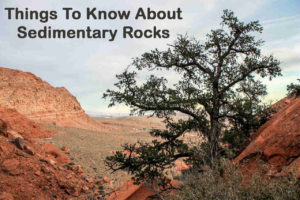Things To Know About Sedimentary Rocks

Sedimentary rocks
Sedimentary rocks are made from layers of sand, mud, and other material that is usually deposited in water or on wet ground. They form when rocks are broken down and eroded by the wind, waves, ice sheets or glaciers, and then redeposited as sediment.
The two main types of rock deposits are clastic deposits (formed from fragments of older rocks) and chemical deposits (formed as a result of chemical reactions). Clastic deposits generally form layers with thinner layers in between them; while chemical deposits often form veins with material running through them.
The composition and nature of sedimentary rocks can often be determined by examination of their grain size or sorting mechanism, which is the means by which sediments settle out (sorted) into a deposit. Sorting mechanisms range from gravity to water flow, including diagenesis. The process of compaction involves changing the landscape, which can lead to changes in sedimentary rocks. Examples of this include folding and faulting.
Sedimentary rocks have many uses, including being used for the construction of buildings and roads. They are also used to make concrete and asphalt, which are used in the construction of roads. They are further used for manufacturing bricks and tiles, as well as sandblasting. In addition, they can be found in sediment cores, which provide information about past environments.
The article will teach you about the three types of sedimentary rocks: shale, sandstone and limestone as well as how they are formed and what their properties are like.
Shale
Shale is composed of clay and is an extremely fine-grained sedimentary rock. It was deposited under low energy conditions, which means it doesn’t contain any sand or mud and the material that it is made from are very small pieces of other rocks or fragments of organic matter. Its particles are so close together that there can rarely be more than one pore space between them, the pores on shale are therefore in no way connected to one another as you may find in a rock-like limestone. Shale contains a lot of water when it is in its natural form, due to this water content shale is highly susceptible to weathering if it comes into contact with the Earth’s surface. This type of sedimentary rock is generally found in basins that were once covered by oceans and rivers that drained into them, and it is also common in continental depositional environments. The formation of shale can be caused by a wide variety of factors. Some common ones include: low-energy deposition, high water to sediment ratios, and other sedimentary rocks being eroded.
Sandstone
Sandstone is composed of sand-sized grains (ranging from 0.0625 mm to 2 mm) and it is made up primarily of quartz grains due to its clean bedding surfaces. What this means is that it forms horizontal layers (beds) due the preservation of its original horizontal bedding surface. Sandstone is a non-foliated sedimentary rock, meaning that it is not rich in platy minerals like mica. The grain size of sandstone relates directly to the rate of its deposition as it was being created. The larger the grain size, the slower it was depositing as there has to be more sediment transported by water or wind for larger grains to be deposited over one another. Sandstone was deposited under high-energy conditions, which means that there can be lots of fine-grained sediments mixed into a rock or just single coarse-grained sediment all by itself.
Sandstone is common in desert areas and places with large amounts of Precambrian rocks like the Canadian Shield (great lakes). The formation of sandstone can be caused by a number of factors, depending on the type of water that was used to deposit it. Some common ones include: high energy depositing conditions, low energy depositing conditions and high energy depositing conditions.
Limestone
Limestone has a chemical composition similar to sandstone as it too is made up of quartz grains but is a lot heavier than sandstone. It can also be found in different forms like cement and dolomite. Because limestone is composed primarily of calcite with some carbonate (CO32-) and aragonite (A2263-) it is white in color. It is also known as limestone is because it has been deposited in an environment of high calcium content, similar to how saltwater has a low calcium content. The lithology of limestone consists of carbonate grains that are held together by mineral cement and it is known as cemented limestones when there are many minerals cementing them together. Limestone was deposited under high-energy conditions, which means that there can be more than one sedimentary rock or just a single sedimentary rock all by itself. Cemented limestone is common in areas where the water input was low and temperatures were high, which can include places like the tropics and high-latitude arctic regions.
Shale and sandstone both have different mechanisms of deposit on a global scale. On a local scale, however, the mechanisms of formation for each type of sedimentary rock are quite similar. The mechanism of formation can be altered dramatically due to tectonic processes but in most cases, it is unlikely that a deposit will be different then what has been described above if the proper conditions were present.
Sedimentary rocks are important for helping us understand the Earth’s past
Sedimentary rocks are incredibly important resources that give us clues about human history. These rock formations, layered over millions of years, tell stories from tiny bacteria all the way to dinosaurs. The layers of rock tell us about climate change, earthquakes, and meteorite impacts. They tell us about the birth and extinction of species.
Compaction
Compaction is the process by which sediments become rock. It occurs on a large scale in the Earth’s crust as it is subduction or higher pressure while on a smaller scale within an individual sedimentary deposit like sandstone. Compaction is caused by the weight of overlying rocks either through tectonic or erosion forces. This weight can be from other sedimentary deposits, igneous intrusion, metamorphism, and even tectonic loading from glaciers or land uplift.
Cementation
Cementation is the process of particles becoming cemented together. The process of cementation can take a few minutes if the particles are in the water and it only takes around 50 years for sediment to become part of the rock.
Granite is one example of igneous rock, but limestone could also be a sedimentary rock because it forms from calcium carbonate that has been used by other marine organisms to build their shells and skeletons before being deposited on the ocean floor. Limestone often contains fossils, which are clues scientists use to figure out how old a particular layer is, as well as what might have happened in that environment over time.
Lithification
lithification is the process by which sediment is turned to solid rock, either through compaction or cementation. The three main types of lithification are physical, chemical, and organic.
There are many different processes that occur in the lithification of sediment which can sometimes lead to the formation of a number of types of rock. In order for sediments to become solid rocks they need time for the elements in them to change into minerals as well as heat and pressure from deep underground. These lithified rocks will form a variety of layers on top that will eventually become part of the earth’s crust layer and continue forming new sediments on top.
One way that lithification can happen is through mechanical lithification which is essentially the process of making rock by pushing or pressing hard against sediment. This process usually happens when sediment sits in water, especially after a lake has dried up. In this case, the sediment and water will form different types of rocks by forming layers that are cemented and compressed together like concrete and the sediment will change into a rock. Another way that lithification can happen is through chemical lithification which happens when materials that contain chemicals from plants or animals are buried in sediments and these chemicals react with each other to form different types of rocks. The minerals in these rocks will then start to change into other minerals but it takes thousands of years for them to completely change.
There’s a lot of organic material in sedimentary rock and that can be used as a source of petroleum and tar
Organic sedimentary rocks are dense and heavy as a result of their high concentration of organic material, like tree bark. They are composed primarily of the remains of dead plants or animals. Crude oil is often found in sedimentary rock. The petroleum-rich rock can be used to produce tar and other substances.
Chemical sedimentary rock
Magnesium – Mg
Calcium – Ca
Iron – Fe
Sodium and Potassium – Na, K
Carbonate minerals such as Calcite and Dolomite
Sulfate minerals such as Gypsum and Anhydrite.
These minerals can dissolve from the surrounding water or form when water evaporates away. They settle to the bottom of a body of water where they are buried by other sediments that come later. These sediments compact under pressure, which alters their chemical composition; this is known as lithification or petrification. Lithified sedimentary rocks form through the conversion of loose sediment into solid rock. This process is called lithification.
Biologic sedimentary rocks
Sedimentary rocks can also form from the remains of once-living organisms. The most common source of carbon in the sedimentary rock record are fossils, especially skeletal remains. Fossils are mostly made up of calcium carbonate which is soluble in water, but only when the pressure on such sediment exceeds that at Earth’s surface. When this condition occurs, carbonates are precipitated and lithify to form sedimentary rock.
The term “sedimentary rocks” is one means of classifying types of rock that form through deposition or deposition-like processes from pre-existing rocks like ash or lava flows.
Read more Facts and Knowledge

